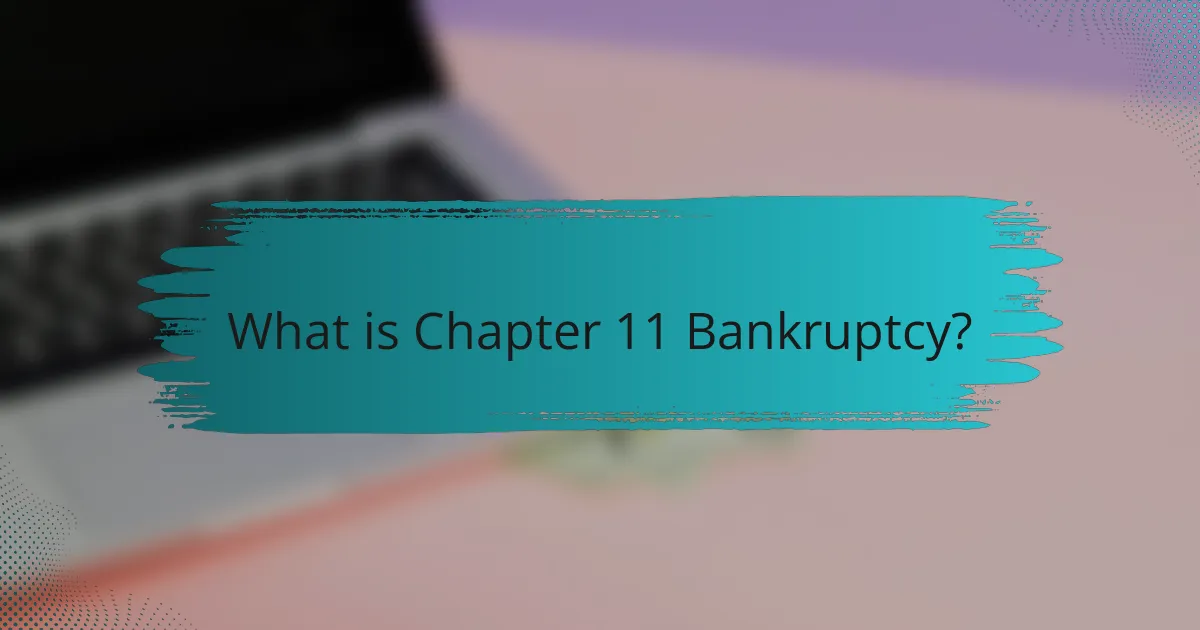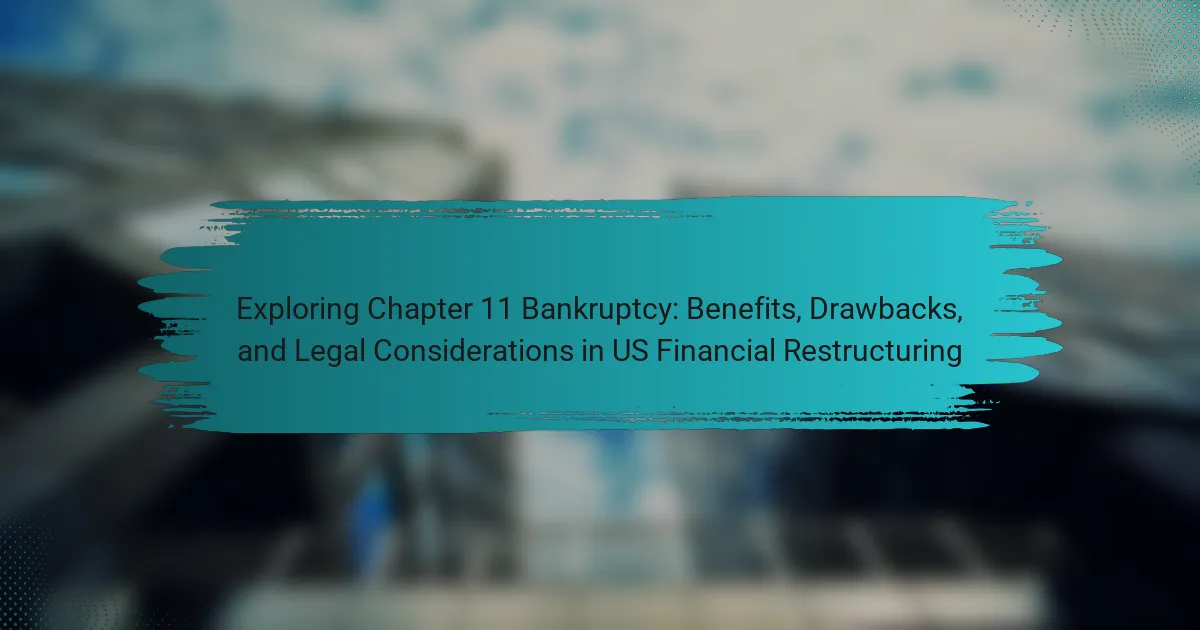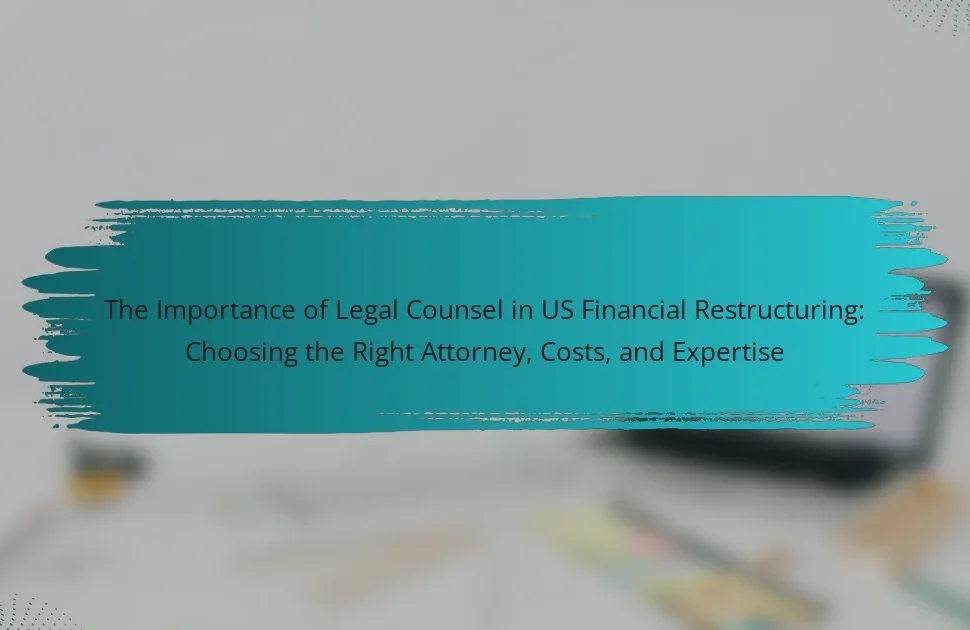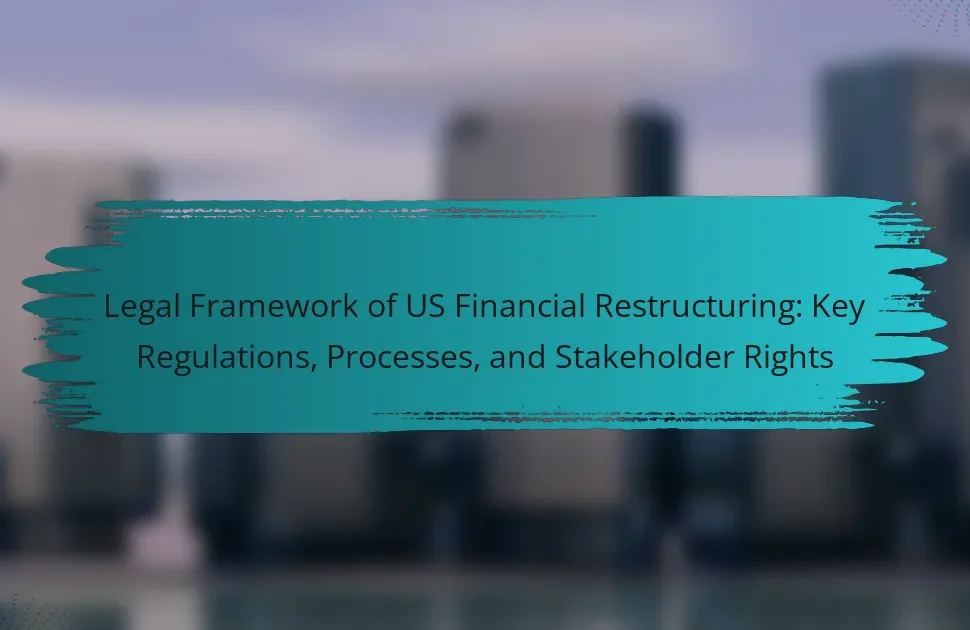Chapter 11 bankruptcy is a legal framework that enables businesses to reorganize their debts while continuing operations and protecting themselves from creditors. This process is commonly utilized by large corporations seeking to return to profitability. Key elements include the submission of a reorganization plan to the bankruptcy court and the opportunity for creditors to vote on this plan. The article explores the benefits and drawbacks of Chapter 11 bankruptcy, along with important legal considerations in the context of financial restructuring in the United States. Understanding these aspects is crucial for businesses navigating financial challenges.

What is Chapter 11 Bankruptcy?
Chapter 11 bankruptcy is a legal process that allows businesses to reorganize their debts. It provides a framework for companies to restructure while protecting them from creditors. Under Chapter 11, a company can continue operations during the reorganization process. This type of bankruptcy is often used by large corporations. It aims to allow businesses to return to profitability. The process involves submitting a reorganization plan to the bankruptcy court. Creditors have the opportunity to vote on this plan. Successful reorganization can lead to reduced debts and improved financial stability.
How does Chapter 11 Bankruptcy function in the US legal system?
Chapter 11 Bankruptcy allows a business to reorganize its debts while continuing operations. It provides a legal framework for businesses to propose a plan to repay creditors over time. This process begins when a company files a petition in bankruptcy court. The filing grants an automatic stay, halting creditor actions against the business.
The company must submit a reorganization plan within a specified period. Creditors then vote on this plan, and it must be approved by the court. If approved, the plan outlines how debts will be repaid and may involve restructuring contracts or selling assets.
Chapter 11 aims to preserve the business as a going concern. It is commonly used by large corporations but is available to any business or individual. The process can be complex and typically requires legal and financial advisors.
Statistically, approximately 10% of Chapter 11 cases result in successful reorganization. This highlights the challenges businesses face during the process. Overall, Chapter 11 serves as a vital tool for financial restructuring in the US legal system.
What are the key processes involved in filing for Chapter 11 Bankruptcy?
The key processes involved in filing for Chapter 11 Bankruptcy include preparing a bankruptcy petition and schedules. The debtor must provide detailed financial information. This includes assets, liabilities, income, and expenses. The petition is filed in federal bankruptcy court. Upon filing, an automatic stay is enacted, halting creditor actions. The debtor typically proposes a reorganization plan to repay creditors. Creditors then vote on the proposed plan. The court must confirm the plan for it to be effective. These processes are outlined in the U.S. Bankruptcy Code, specifically under Chapter 11 provisions.
How does the court oversee Chapter 11 Bankruptcy proceedings?
The court oversees Chapter 11 Bankruptcy proceedings by maintaining jurisdiction over the case. It ensures compliance with the Bankruptcy Code and monitors the debtor’s operations. The court approves significant business decisions made by the debtor, such as asset sales and financing arrangements. It also reviews and confirms the debtor’s reorganization plan. This plan must be fair and feasible, meeting the requirements of the creditors. The court holds hearings to address disputes among creditors and the debtor. Additionally, the court appoints a trustee if necessary to protect the interests of creditors. These functions are crucial for maintaining order and fairness in the bankruptcy process.
What are the primary benefits of Chapter 11 Bankruptcy?
Chapter 11 Bankruptcy provides several primary benefits. It allows businesses to restructure their debts while continuing operations. This process can help preserve jobs and maintain business relationships. Additionally, it offers protection from creditors during the reorganization period. Companies can negotiate more favorable terms with lenders. This can lead to a sustainable business model post-bankruptcy. Furthermore, Chapter 11 can enhance the chances of a successful turnaround. According to the American Bankruptcy Institute, about 60% of Chapter 11 cases result in a confirmed plan. This statistic underscores the effectiveness of the Chapter 11 process in facilitating business recovery.
How can Chapter 11 Bankruptcy help businesses restructure their debts?
Chapter 11 Bankruptcy allows businesses to reorganize their debts while continuing operations. It provides a legal framework for negotiating new payment terms with creditors. Businesses can propose a restructured repayment plan that fits their financial situation. This plan must be approved by the court and creditors. During this process, the business is protected from creditor actions, allowing it to stabilize. A successful reorganization can lead to reduced debt obligations and improved cash flow. According to the American Bankruptcy Institute, many companies emerge stronger after Chapter 11 proceedings. This process ultimately aims to help businesses regain profitability and sustainability.
What advantages does Chapter 11 provide to debtors during the process?
Chapter 11 provides several advantages to debtors during the process. It allows debtors to reorganize their debts while maintaining control of their business operations. This is known as “debtor-in-possession” status. Debtors can propose a reorganization plan that must be approved by the court. This plan can include reducing debts or extending payment terms. Additionally, Chapter 11 provides an automatic stay, which halts all collection activities against the debtor. This gives debtors breathing room to develop their plan. Creditors are also often more willing to negotiate during this process. Overall, Chapter 11 offers a structured environment for financial recovery.
What drawbacks are associated with Chapter 11 Bankruptcy?
Chapter 11 Bankruptcy has several drawbacks. It can be a lengthy and costly process. Legal fees and administrative expenses can accumulate quickly. Businesses may face operational disruptions during restructuring. Stakeholder relationships can become strained. The process may not guarantee successful reorganization. There is also a risk of losing control over business decisions. Additionally, it can negatively impact credit ratings. Lastly, it may lead to liquidation if reorganization fails.
What are the potential costs involved in filing for Chapter 11 Bankruptcy?
The potential costs involved in filing for Chapter 11 Bankruptcy include legal fees, court fees, and administrative expenses. Legal fees can vary significantly based on the complexity of the case. They can range from tens of thousands to several million dollars. Court filing fees are typically around $1,717 as of 2023. Administrative expenses may include costs for financial advisors, accountants, and other professionals. These costs can accumulate quickly, often reaching hundreds of thousands of dollars. Additionally, there may be costs related to the restructuring plan and ongoing operations during the bankruptcy process. Overall, the total costs can be substantial, impacting the financial viability of the business.
How does Chapter 11 Bankruptcy impact a company’s credit rating?
Chapter 11 Bankruptcy significantly lowers a company’s credit rating. This legal status indicates financial distress and can lead to increased borrowing costs. Credit rating agencies often downgrade the company’s ratings during the bankruptcy process. A lower credit rating restricts access to capital markets and affects relationships with suppliers. Companies may face higher interest rates on future loans due to perceived risk. The negative impact on credit ratings can last for years, even after successful reorganization. This long-term effect complicates future financing and operational recovery efforts.
What legal considerations should be kept in mind during Chapter 11 Bankruptcy?
During Chapter 11 Bankruptcy, legal considerations include the need for a comprehensive reorganization plan. This plan must be filed with the court and approved by creditors. The debtor must disclose all assets and liabilities accurately. Compliance with the Bankruptcy Code is essential throughout the process. The automatic stay protects the debtor from creditor actions upon filing. Additionally, the debtor must maintain regular reporting to the court. The court’s approval is required for significant transactions during the bankruptcy. Lastly, understanding the implications of dischargeability of debts is crucial.
What are the essential legal requirements for filing Chapter 11 Bankruptcy?
The essential legal requirements for filing Chapter 11 Bankruptcy include the need for a debtor to be a person or entity with debts. The debtor must also reside or have a business in the United States. A petition must be filed in the bankruptcy court. The petition includes detailed financial information. This information consists of assets, liabilities, income, and expenses. The debtor must also submit a proposed plan for reorganization. This plan outlines how debts will be repaid over time. Additionally, the debtor must pay a filing fee to the court. Failure to meet these requirements may result in dismissal of the case.
How do creditors’ rights play a role in Chapter 11 proceedings?
Creditors’ rights significantly influence Chapter 11 proceedings. These rights determine how creditors can recover debts during bankruptcy. Creditors can file claims to assert their interests in the debtor’s assets. They have the right to vote on the proposed reorganization plan. This vote can affect whether the plan is accepted or rejected. Creditors also have the right to receive information about the debtor’s financial status. They may challenge the debtor’s plans if they believe their rights are not being protected. The Bankruptcy Code outlines these rights clearly, ensuring creditors have a voice in the process. Thus, creditors’ rights are essential for maintaining fairness in Chapter 11 proceedings.
How does Chapter 11 Bankruptcy compare to other bankruptcy options?
Chapter 11 Bankruptcy allows businesses to reorganize while continuing operations. This option differs from Chapter 7, which involves liquidation of assets. In Chapter 11, debtors propose a plan to repay creditors over time. This can help preserve the business and jobs. Chapter 13 Bankruptcy is another alternative, primarily for individuals. It enables debt repayment over three to five years while keeping assets. Each bankruptcy type has unique eligibility requirements and implications. Chapter 11 typically requires more complex legal processes and higher costs than Chapter 7 or 13. However, it offers a chance for recovery that liquidation does not.
What distinguishes Chapter 11 from Chapter 7 and Chapter 13 bankruptcies?
Chapter 11 bankruptcy differs from Chapter 7 and Chapter 13 in its purpose and process. Chapter 11 primarily focuses on business reorganization, allowing companies to restructure debts while continuing operations. In contrast, Chapter 7 involves liquidation of assets to pay creditors, often resulting in business closure. Chapter 13 allows individuals to create a repayment plan to pay off debts over time while keeping their assets. Additionally, Chapter 11 requires a court-approved plan for reorganization, while Chapter 13 has a repayment plan based on income. This distinction highlights Chapter 11’s emphasis on preserving business operations compared to the liquidation focus of Chapter 7 and the repayment structure of Chapter 13.
What are the implications of choosing Chapter 11 over other bankruptcy types?
Choosing Chapter 11 bankruptcy allows for business reorganization while maintaining operations. This contrasts with Chapter 7, which involves liquidation. Chapter 11 provides a chance to restructure debts and develop a repayment plan. It offers flexibility in negotiations with creditors, which can lead to better terms. Unlike Chapter 13, Chapter 11 is available to larger businesses and does not have a debt limit. The process can be lengthy and costly, requiring significant legal and administrative resources. However, successful reorganization can lead to business survival and future profitability.
What are the best practices for navigating Chapter 11 Bankruptcy?
The best practices for navigating Chapter 11 Bankruptcy include thorough preparation, accurate financial reporting, and effective communication with stakeholders. Businesses should assess their financial situation comprehensively before filing. This includes understanding liabilities, assets, and cash flow. Accurate financial reporting is crucial for transparency and building trust with creditors. Developing a solid reorganization plan is essential. This plan should outline how the business intends to restructure its debts. Regular communication with creditors and stakeholders helps maintain relationships and ensures support for the reorganization plan. Engaging experienced legal and financial advisors can provide valuable guidance throughout the process. Following these practices increases the likelihood of a successful reorganization under Chapter 11.
How can businesses prepare effectively for a Chapter 11 filing?
Businesses can prepare effectively for a Chapter 11 filing by conducting a thorough financial assessment. This involves evaluating assets, liabilities, and cash flow projections. Creating a detailed reorganization plan is crucial. This plan should outline how the business intends to restructure debts and operations. Engaging with legal and financial advisors is essential for navigating the complexities of bankruptcy law. They can provide guidance on compliance and strategy. Additionally, communicating transparently with stakeholders helps maintain trust and manage expectations. Preparing necessary documentation, such as financial statements and creditor lists, is vital for the filing process. These steps increase the likelihood of a successful restructuring under Chapter 11.
What common pitfalls should be avoided during the Chapter 11 process?
Common pitfalls to avoid during the Chapter 11 process include inadequate financial projections. Accurate financial forecasting is crucial for a successful restructuring plan. Failing to communicate effectively with creditors can lead to mistrust and opposition. Neglecting to comply with court deadlines can result in dismissal of the case. Underestimating the costs of the process can lead to insufficient funding for operations. Lack of transparency in reporting can damage relationships with stakeholders. Additionally, not engaging experienced legal and financial advisors can hinder the restructuring efforts. These pitfalls can significantly impact the outcome of a Chapter 11 bankruptcy case.
Chapter 11 Bankruptcy is a legal process that enables businesses to reorganize their debts while continuing operations, providing a framework for financial restructuring. The article outlines the functioning of Chapter 11 within the US legal system, detailing the key processes involved, benefits, and drawbacks associated with this bankruptcy type. It also covers the essential legal requirements for filing, the impact on credit ratings, and how creditors’ rights play a role in proceedings. Furthermore, comparisons with other bankruptcy options, best practices for navigating Chapter 11, and common pitfalls to avoid are discussed, offering a comprehensive overview of this critical financial tool.




